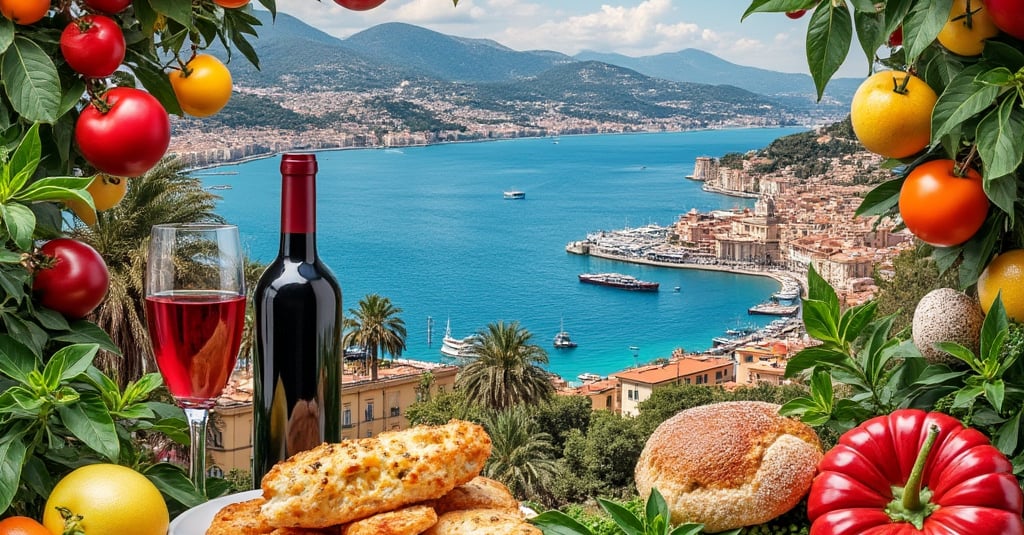Culinary Marketing: Exploring the Flavors of Nice
Dive into the culinary delights of Nice, suggesting how food festivals, local cuisine, and wine can be central themes in marketing strategies for restaurants, food brands, or culinary tourism.


Introduction to Culinary Marketing in Nice
Culinary marketing is an emerging field that leverages the flavors, traditions, and culinary heritage of specific regions to promote restaurants, food brands, and culinary tourism. In the case of Nice, the city’s rich gastronomic landscape, deeply rooted in history and tradition, offers a unique avenue for such marketing endeavors. Renowned for its Mediterranean cuisine, Nice boasts an array of locally sourced ingredients and authentic culinary practices that have been passed down through generations.
The local cuisine of Nice, characterized by dishes such as socca, ratatouille, and Niçoise salad, represents the essence of regional identity. These culinary delights are not just food items; they are cultural artifacts that tell a story of heritage and tradition. By focusing on these unique elements, restaurants and food brands can differentiate themselves in a competitive market, attracting both locals and tourists seeking authentic gastronomic experiences.
Food festivals play a critical role in culinary marketing. Events such as the Nice Carnival and the Fête de la Cuisine provide platforms for showcasing local cuisine to a broader audience, creating buzz and drawing crowds from near and far. These festivals celebrate the culinary diversity of the region, often featuring live cooking demonstrations, tastings, and interactive workshops. They serve as excellent opportunities for businesses to engage with potential customers, build brand awareness, and foster community relations.
Additionally, the wine traditions of Nice contribute significantly to its culinary appeal. The region is home to exceptional vineyards producing world-class wines that complement the local cuisine. Wine tastings and vineyard tours offer immersive experiences that enhance the city’s appeal as a culinary destination. For marketers, integrating these wine traditions into promotional strategies can attract oenophiles and food enthusiasts alike, offering a well-rounded gastronomic experience.
Understanding the intrinsic value of Nice’s culinary heritage is essential for crafting effective marketing strategies. By leveraging the city’s unique flavors, food festivals, and wine traditions, culinary marketing in Nice can create compelling narratives that resonate with diverse audiences, driving both local engagement and tourism.
Leveraging Local Cuisine in Marketing Campaigns
Nice’s culinary landscape is rich with tradition and uniquely Mediterranean flavors, presenting a wealth of opportunities for marketing campaigns. Highlighting local cuisine not only accentuates authenticity but also connects directly with food enthusiasts and travelers seeking cultural experiences. Central to this strategy are key dishes and ingredients that embody the essence of Nice.
Essential in this regard is the iconic Salade Niçoise, a colorful medley of fresh vegetables, olives, tuna, anchovies, and hard-boiled eggs, dressed typically with olive oil. This dish exemplifies healthy, vibrant living and can be spotlighted in marketing efforts to convey freshness and local tradition. For instance, showcasing the process of selecting market-fresh ingredients and preparing Salade Niçoise can provide an authentic narrative that appeals to health-conscious travelers and culinary aficionados alike.
Another culinary gem from Nice is Socca, a savory chickpea pancake, crisp on the edges and tender within. It's traditionally cooked in a wood-fired oven, reflecting centuries-old cooking practices. For marketers, Socca offers a pathway to emphasize the historic and artisanal facets of Nice’s gastronomy. Campaigns could feature visual storytelling, highlighting local chefs expertly making Socca, thereby ingraining a sense of heritage and craftsmanship.
Ingredients such as olives, capers, and a variety of aromatic herbs are not only fundamental to Niçoise cuisine but also powerful symbols of the region’s agricultural bounty. Incorporating these ingredients into marketing narratives can evoke images of sun-drenched groves and fields, framing Nice as a destination ripe with natural splendors.
The art of storytelling is paramount in showcasing these culinary delights. By weaving tales around the origin, preparation, and cultural significance of dishes like Salade Niçoise and Socca, marketers can create compelling content that resonates at an emotional level. Emphasizing personal stories of local farmers, fishermen, and chefs can offer a genuine glimpse into the community’s bond with its cuisine, enriching the overall narrative.
In essence, leveraging Nice’s local cuisine in marketing campaigns not only highlights the city’s gastronomic treasures but also delivers an immersive cultural experience, enticing food enthusiasts and tourists to savor the true flavors of Nice.
Harnessing the Power of Food Festivals
Food festivals in Nice serve as quintessential platforms for culinary marketing, offering brands a unique opportunity to engage with a diverse array of food enthusiasts. Key among these festivals is the famous Nice Carnival, a vibrant spectacle attracting both locals and tourists. This event is renowned not only for its parades and performances but also for its extensive culinary offerings, providing businesses with an invaluable chance to showcase their products. Likewise significant is the Fête de la Musique, an annual celebration where music and food unite to create an unforgettable experience.
In leveraging these festivals for marketing purposes, forming strategic partnerships is paramount. Collaborating with festival organizers can help secure prime locations for product booths and ensure participation in key events within the festival itinerary. It's also beneficial to design interactive culinary events such as cooking demonstrations or tasting sessions. These activities not only draw in festival attendees but provide direct interaction with potential customers, making it easier to introduce and promote new products or services.
Maximizing visibility during these festivals requires meticulous planning. Pre-event promotions via social media, local advertising, and collaboration with influencers can build anticipation and drive more footfall to your booth. Once on-site, engaging stall designs, attractive displays, and compelling, easy-to-read signage can help capture attention. Offering exclusive discounts or festival special products can create a sense of urgency and encourage purchases.
Finally, engagement doesn't end when the festival closes. Post-event follow-up is crucial. Collecting customer information during the festival allows for email marketing campaigns that can nurture leads and convert one-time visitors into loyal customers. Sharing festival highlights and user-generated content on social media channels can extend the event's momentum, maintaining your brand's visibility long after the festival has concluded.
``````html
Wine Tourism: An Untapped Marketing Opportunity
Nice, with its idyllic location on the French Riviera, is not only known for its stunning coastline but also for its rich wine culture. Local vineyards, set against picturesque landscapes, offer a variety of exceptional wines. These vineyards represent a largely untapped opportunity for marketing campaigns centered around wine tourism. By leveraging the allure of wine-tasting experiences, businesses in Nice can create distinctive and appealing promotions.
One effective strategy involves establishing partnerships with local wineries. Such collaborations could include organizing exclusive vineyard tours that allow tourists and enthusiasts to witness the wine-making process firsthand. These tours provide a unique and immersive experience, deepening visitors' appreciation for the craft and history of local wines. For instance, a collaboration between a prominent hotel and a nearby vineyard could offer guests special tour packages, complete with guided tastings and educational sessions about the region's wine heritage.
Additionally, hosting wine tasting events can significantly elevate the marketing potential of Nice's wine tourism. These events can be tailored to different audiences, ranging from intimate sessions for connoisseurs to larger festivals celebrating local wines. Events like these not only attract tourists but also engage the local community, fostering a sense of pride and connection to the region's vinous tradition.
To further capitalize on wine tourism, incorporating wine-themed social media challenges and content creation can be highly effective. Engaging audiences through visually appealing content—photos, videos, and stories showcasing vineyard tours and wine-tasting events—can create a buzz online. Challenges like "Share Your Best Wine Tasting Moment" could encourage user-generated content, enhancing visibility and engagement across social platforms.
Through these strategic initiatives, wine tourism presents a compelling avenue for promoting the unique flavors of Nice. By crafting experiences that blend education, enjoyment, and social interaction, businesses can tap into a rich vein of potential customers, creating memorable moments and lasting impressions.
```
Experiential Marketing Strategies
Experiential marketing has emerged as a powerful tool in the culinary industry, focusing on creating immersive experiences that engage all the senses. This approach goes beyond traditional marketing, offering consumers memorable interactions that leave lasting impressions. One of the key strategies involves organizing cooking classes. These classes provide participants with not only the hands-on experience of preparing dishes but also the opportunity to connect with the brand on a personal level. Cooking classes often foster a sense of community and brand loyalty, as participants share their culinary creations and experiences.
Another effective experiential marketing strategy is the chef's table experience. This exclusive event allows a select group of customers to dine in the kitchen, observing firsthand the artistry and skill of the chefs. The close interaction with culinary professionals, coupled with an intimate dining setting, creates a unique and unforgettable experience. Businesses leveraging this strategy can highlight their commitment to quality and craftsmanship, reinforcing their brand’s premium status.
Interactive food tours offer yet another innovative way to engage consumers. By guiding participants through a curated selection of culinary destinations, these tours provide an educational and sensory-rich experience. Each stop becomes an opportunity to showcase products, share the brand’s story, and create meaningful connections with participants. These tours not only highlight the diversity and richness of the culinary landscape but also enhance brand positioning by associating it with a remarkable journey of taste and discovery.
The benefits of creating such multi-sensory marketing events are substantial. By enabling participants to taste, smell, and touch products, brands can create deeper emotional connections and foster stronger customer loyalty. In the culinary sector, where sensory experiences are paramount, this approach is particularly effective. Notable examples of successful experiential marketing campaigns include pop-up restaurants that offer themed dining experiences and immersive food festivals that blend culinary delights with entertainment and cultural elements. These initiatives not only attract media attention but also drive word-of-mouth marketing, amplifying the reach and impact of the campaigns.
Utilizing Social Media for Culinary Challenges and Engagement
In the realm of culinary marketing, social media platforms like Instagram, TikTok, and Facebook have become indispensable tools for engaging audiences. They provide unique opportunities for brands to create dynamic and captivating content, which is crucial for sustaining interest and fostering community engagement.
Creating food photography contests and recipe challenges are practical strategies that can significantly enhance user interaction. Encourage followers to participate by submitting their best food photos or innovative recipes, and reward winners with prizes or features on your social media channels. This approach not only increases engagement but also generates valuable user-generated content that can be repurposed for further marketing efforts.
Virtual cooking sessions have also gained traction as a means of connecting with audiences. Hosting live cooking demonstrations or tutorials allows brands to showcase their culinary skills while engaging with viewers in real-time. These sessions can be interactive, with participants asking questions and receiving immediate feedback from the host, thereby enriching the user experience.
Collaborating with influencers is another effective strategy for expanding reach and enhancing credibility. Influencers can introduce your brand to their followers, adding a layer of trust and authenticity. When selecting influencers, consider those whose culinary style and audience align with your brand to ensure a natural fit.
Utilizing hashtags is essential for increasing visibility on social media. Branded hashtags can help track participation in contests and challenges, while trending hashtags can attract a broader audience. Encourage followers to use these hashtags in their posts to boost community engagement and content discovery.
Numerous success stories illustrate the effectiveness of these strategies. For instance, challenges like the "Whipped Coffee" trend on TikTok or the "Dalgona Challenge" have gone viral, showcasing the power of creative culinary content. These campaigns highlight how engaging and interactive social media initiatives can elevate a brand's presence and foster a deeper connection with its audience.

